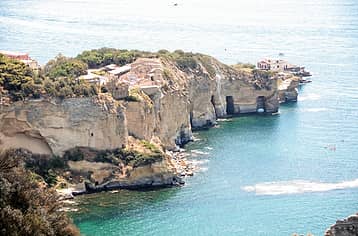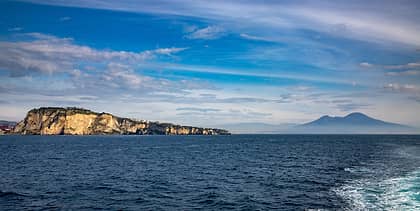- Home
- Experiences
- The Best Beaches in Naples
The Best Beaches in Naples

Naples sits directly on the sea and its history, lore, and cuisine are intrinsically tied to the Mediterranean. That said, though the city stretches along the bay, there are not many true beaches within its limits and thus Naples is not traditionally considered a "seaside destination", as it were.
If you are set on a beach break, however, don't despair! With our insider tips, you can find a handful of delightful spots in and near the city where you can relax and sunbathe on the water's edge and even take a dip to beat the summer heat.
Read on to learn about the top beaches in and near Naples!
Posillipo: Bagno Sirena and Bagno Elena
Posillipo: Bagno Sirena and Bagno Elena

One of the most famous beaches in Naples sits below the beautiful Palazzo Donn'Anna in the Posillipo neighborhood. The beach is spacious and sandy and the water is generally quite clear. If you prefer to relax at private beach clubs, choose Bagno Elena or Lido Sirena, two of the most storied in the city that offer a variety of services and amenities, including a restaurant.
How to Reach the Beach in Posillipo
You can take a taxi to the beach below Palazzo Donn'Anna or bus 140 from Mergellina or Via Caracciolo (get off at the Posillipo - Palazzo Donn'Anna stop). If you're setting off from the historic center or the train station, take bus 151 from Piazza Garibaldi and then change to bus 140 in Piazza Vittoria.
This beach can be crowded on the summer weekends, but most beaches in Naples see the lion's share of sunbathers on Saturdays and Sundays in July and August. To enjoy the waterfront without the hordes, plan on visiting during the week.
The Gaiola Marine Reserve
The Gaiola Marine Reserve

The underwater archaeological park of Gaiola is one of the most beautiful stretches of coastline in Naples, as well as an important nature and cultural reserve. The park stretches from the delightful hamlet of Marechiaro on the Posillipo coast and includes two islets connected by a small bridge. The water here is usually clear and the views are breathtaking, with lush countryside dotted with archaeological ruins.
How to Reach the Gaiola Marine Reserve
If you do not have a car, you can take the following busses to Gaiola:
140 from Mergellina, C31 from Vomero, C21 from Mergellina (Discesa Coroglio - Istituto Denza stop). From the bus stop, walk to the Discesa Gaiola to reach the beach on foot. Otherwise, you can take the C1 bus from Fuorigrotta (Capo Posillipo stop, the final stop on the route).
Since this is a marine reserve, not all areas of the Gaiola coastline are open to bathers. The park's Zone A is off-limits, whereas Zone B is open to up to 100 visitors a day and swimming and sunbathing is allowed. The park's free public beach is made up of coastal rocks and boulders and is open from 10 a.m. to 4 p.m. in the summer and from 10 a.m. to 2 p.m. in the winter. The entire park is closed Mondays all year round.
The Gaiola reserve offers a number of activities like guided visits, diving and snorkeling excursions, and tours via glass-bottomed boats. These activities must be booked and paid for individually.
The Marechiaro Cliffs
The Marechiaro Cliffs

Though not technically a beach, the "Scoglione di Marchiaro", or Marechiaro Cliffs, are one of the best spots in Naples for swimming if you don't have your heart set on a stretch of sand and can do without a full-service beach club. This cliff is made up of a large, flat table of volcanic tufo rock just off the coast of Marechiaro in the Posillipo neighborhood, and can only be reached by boat from the port in Marechiaro. Set offshore from the city, this cliff is less crowded than other nearby popular beaches and the water is generally crystalline.
Our Insider Tips
The coastal rocks and boulders on the Scoglione di Marechiaro can be quite slippery due to algae and salt deposits, so we suggest taking along water shoes or wearing shoes with non-slip soles.
There are a couple of stands on the Scoglione di Marechiaro with snack bars and beach chair rentals, but the chairs sell out quickly on the weekends in July and August. Once you rent a beach chair, you are free to set it up where you prefer along the cliff.
Natural Springs
If you enjoy exploring truly wild places and are a strong swimmer, you can ask your skipper to take you past the Scoglione and leave you in an area called the “Acque Minerali”, or natural springs. This is a rock formation set a bit farther from the coast that doesn't offer any services (snack bars, chair rentals, etc.) but also has very few visitors. The water and views here are worth the trouble, but make sure you bring food and water with you and are extra cautious getting in and out of the water.
La Rotonda Diaz
La Rotonda Diaz

This is the most centrally located beach in Naples, set along Via Caracciolo on the city's waterfront. A sandy stretch that is very popular among locals who call it "Mappatella Beach", Rotonda Diaz has recently been spruced up and is now a pleasant seaside spot.
Given its convenient location and popularity with Neapolitans, this beach is generally quite crowded and chaotic, especially in the summer. The water and sand are not always the cleanest and can be somewhat offputting if you are looking for a sparkling beach and crystalline sea.
Though this may not be the place where you would want to spend "an entire day at the seaside", this beach in central Naples is suitable for a quick break overlooking the water or a stop to relax over a cold beer to break up your sightseeing. It also offers a chance to rub shoulders with locals in an authentic city hotspot.
The Phlegraean Fields
The Phlegraean Fields

If you are up for striking out a bit farther along the coast, you can head to the Campi Flegrei, or Phlegaean Fields about 40 minutes outside downtown Naples (traffic permitting). This stretch of coastline is dotted with a number of volcanic beaches of varying sizes, both free public beaches and private beach clubs with snack bars, chair rentals, and other amenities.
Visiting the Phlegraean Fields (I Campi Flegrei)
We particularly recommend the Castello di Baia beach or the spacious coastlines of Miseno and Miliscola.